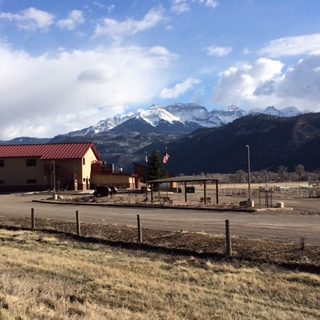
Ridgeway, Colorado
I’m holding my first Grammy. It is heavier than I thought- about 6 or 7 pounds, I suspect. I find out later the weight is due to its components, or as the maker calls it, Grammium, a mixture of Zinc, aluminum, and a “secret ingredient”. The Grammy is beautiful, bronze-golden, and I haven’t done anything to get it. I haven’t had a hit song. All of the music I write has ended up in plays or played mostly alone at my piano. But a serpentine path that suddenly presents itself as a straight line has brought me from Long Island City, Queens to Ridgeway, Colorado, for what I can only imagine has something to do with the most prestigious award in global music, which now sits squarely in my paw. Oh, did you think I was in Los Angeles?
Selecting the winners of Grammys, the chosen few, it turns out, is a complicated affair. To understand how a Grammy ends up in an artist’s hands is to take a look at the process behind which they are made in a little town called Ridgeway, and understand how America functions. To understand a winner, we must examine the complicated lives of America’s many losers. In Ridgeway, Colorado, winning and losing is not separated into neat piles distinguished by awards. Here, things are a little more…complicated.
…”you can’t just tell a good story, you gotta make one”
I found myself standing outside a small shop reading “Home of the Grammy’s” in March 2018 completely by accident. Workshopping my play, The Wildest Ones, at The Arc in Long Island City, it suddenly became clear that the play, which took place on a mustang ranch for troubled teens in the ‘90s, would benefit from my also being on a horse ranch, something I had not done since I was myself a very troubled teen in the ‘90s. John Belitsky, owner and founder of The Arc, told me “ you gotta go to a goddamn horse ranch- you can’t just tell a good story, you gotta make one”. And while it seemed like an impossibility to me at the time -living in Queens, I was far from horse ranch territory- days later, thanks to John’s pushing, an airplane ticket grant sponsored by Charlie Cortese (investor in my theater company, Slightly Altered States) and the serendipitous generosity that Queens-native “the horse lady,” Alice Billings showed towards another Queens artist, I found myself in Ridgeway, Colorado staying at Alice’s Thunder Heart Haven horse ranch, complete with llamas which are, apparently, excellent guard animals, capable of fending off the many predators that live in the mountains here.
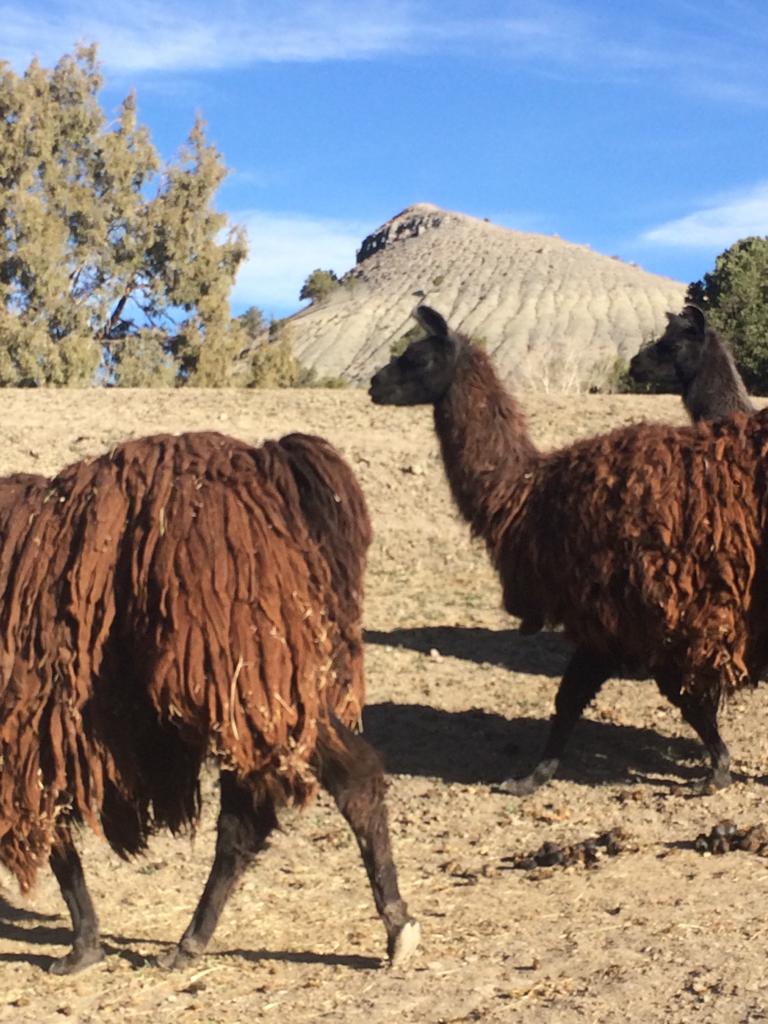
llamas at Thunder Heart Haven horse ranch
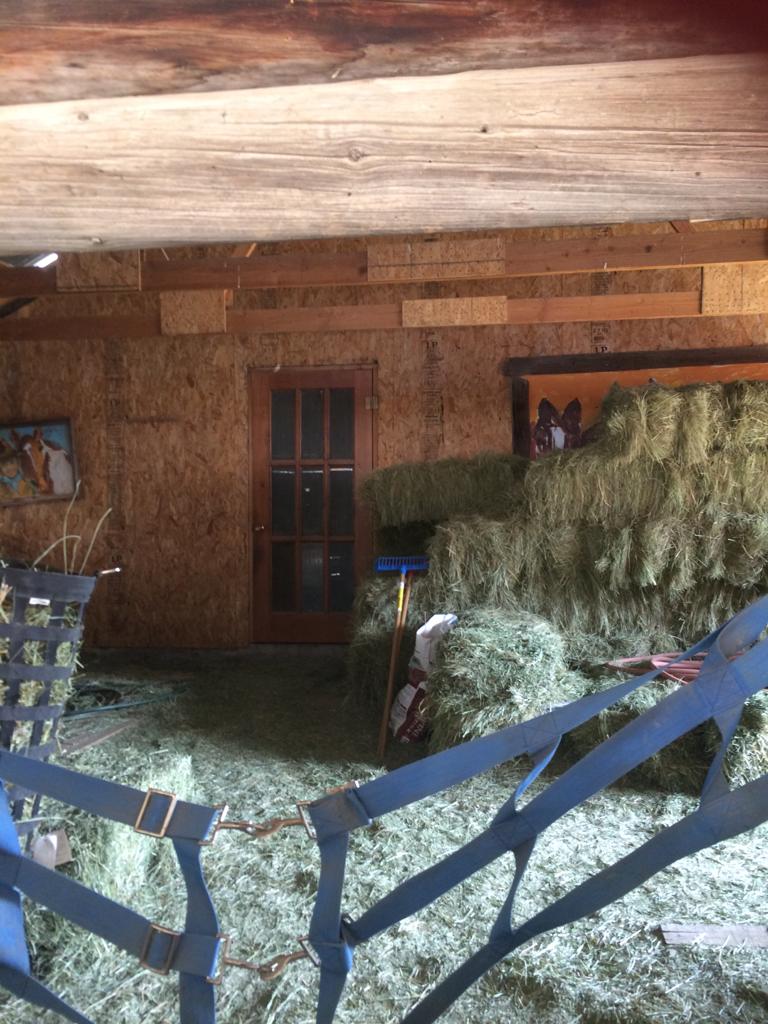
Barn Chore Time! (In Alice’s barn)
Hours earlier I had been locked in a giant warehouse that was a 20,000 square foot former sushi factory-turned performance venue in the forgotten industrial zone that the Arc calls home, for one of our marathon, all night jam sessions in a snowstorm that had grounded all flights leaving LaGuardia airport. All at once, and by some kind of a miracle, I was thrust out of the rapidly gentrifying quarters of Western Queens and transplanted out West, standing before acres of untouched land where wild horses pounded across plains, next to a strangely attractive woman in a cowboy hat with a rifle. Two thousand miles from the hand to hand combat of urban condo development warfare, a battle for ideas, life and land was playing out in parallel to NYC. Here the stakes were less obvious, the victors more quiet, the need for resources more immediately clear, but the spoils were essentially the same.
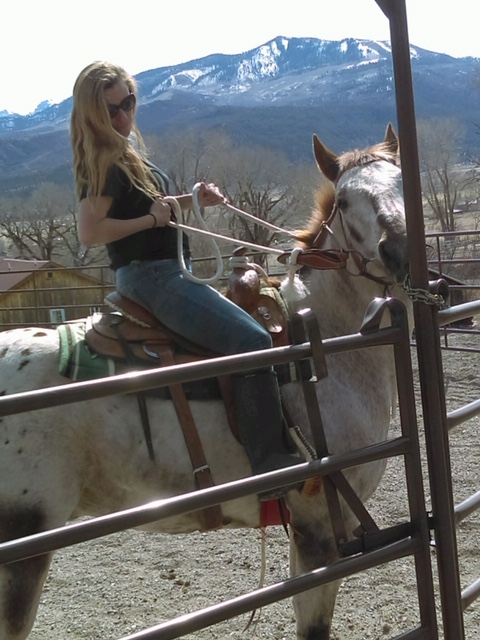
Konnie Fries training Gus at Thunder Heart Haven horse ranch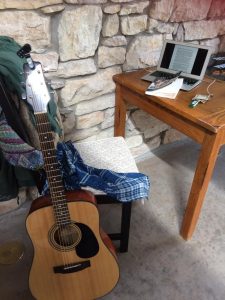
In between waking up at 6am to do barn chores, reading through hundreds of horse training and behavior books (courtesy of Alice’s barn library), playing music, and visiting Alice’s horse trainer and watching his protege Konnie train Alice’s horse onsite, I procrastinated on my play by wandering around town. And that was how one snowy morning almost a year ago, I found myself standing outside of the small workshop where the 700 Grammy awards handed to the most accomplished artists in the world every year are made.
I took a picture and sent it to John: “I think I’m in the home of the Grammys.”
“What the fuck are you doing in Los Angeles?”
“No! The guy who makes them is in Ridgeway …Colorado.”
“What’s his name?”
“They call him the Grammy Man.”
There was a pause, then, classic John: “Go find him!”
I rushed back to the ranch to talk to Alice. She was in her barn, preparing individual horse feed for each of her nine horses. Thunder, the mustang, had a special alfalfa mix. At 34 years old, Thunder was Alice’s first horse. Thunder was a present from Alice’s last ex-husband, a musician and artisan who bought the mustang on a whim one night from a Mexican cowboy while they were out dancing at a California bar. He needed some quick cash to return home fast. Fast enough that he sold the horse for a song. Probably he was in trouble with the law, or worse, the other side of the law. Little did Alice (a schoolteacher at the time) know that Thunder would be the first of many horses who would find a home at her future ranch, Thunder Heart Haven, a sanctuary for horses.
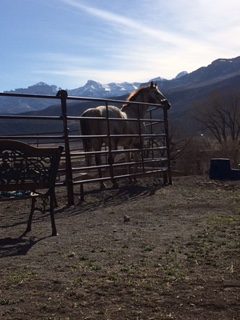
Gus, a senior rescue horse, taking in the sun at Thunder Heart Haven ranch
Thunder was also the name of the mustang in the play I was writing, named for the real horse I had known as a teenager, and Alice and I bonded over the strange coincidences that had brought two women from Queens to Colorado to share this moment. It seemed an impossibility too coincidental to be happening, or as she called it “Bashart”: Yiddish for “meant to be”. I had a feeling it was “fakakta”- totally fucked.
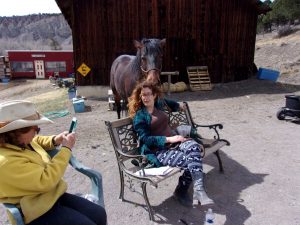
Libby the Mustang, Alice, and me, bonding over strange coincidences
I was quickly spiraling down into the world of my play which, of course, was also my past. Colorado’s progressive marijuana laws and my proximity to a legal dispensary did nothing to stem that tide. I had come to Colorado to reawaken my approximate past, and was too literally in a world I thought I had left years ago. Also legal edibles were surprisingly more potent than garden variety black market fare.
I asked Alice if she knew how I could find the man who made the Grammys. She paused for a moment, cowboy hat shielding her face.
“Yes.” She said at last.
“What’s his actual name?”
“Oh. John. John Billings?”
“Do you…know him?”.
She laughed, “You could say that. I was married to him. I’ll give him a call.”
I wondered what else I should ask the universe for.
“But first,” Alice looked at me sternly, “We are doing what you came here for. We are going to see the wild horses.”
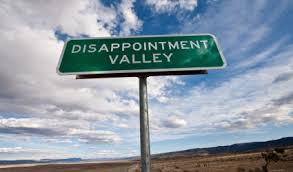
Early the next morning I find myself in Disappointment Valley. TJ Holmes, the attractive woman with the rifle (it is a dart gun, actually). TJ lives here with many cats and her own horses, her windows look out onto the vast 21,932 acres of Spring Creek Basin‘s public land where she spends her time monitoring and documenting the wild horse herds.
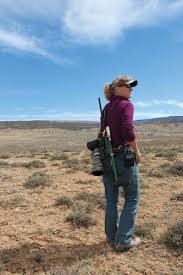
T.J. Holmes credit Pam Nickoles
Spring Creek Basin is public land, managed by The Bureau of Land Management (BLM), a government agency with roots that date to 1812, which was formed at first to encourage homesteading, and has since evolved to preserve and manage land “from National Conservation Lands to our nation’s cultural resources to fish and wildlife habitat”, as the BLM states on their website. BLM is enormously controversial. The BLM’s purported agenda is to monitor the horses population growth, as they claim the horses are starving and becoming inbred; but there are dart guns (like the one carried by TJ) that can be used to inject the mares with birth control rather than removing or destroying the animals. A different, hidden BLM agenda seems to be getting rid of the horses to make way for livestock and other corporate interest. And it is a shared consensus that the BLM roundups are dangerous and cruel. What’s more, the ranchers claim the wild horses ruin the grass for their cattle but horses actually co-exist with the land’s resources quite well; they don’t tear the grass up by the roots (as cow and sheep tend to do) and their manure also contains grass fiber, thereby effectively reseeding the land. Ranchers in Utah, hurt by a long drought, have been pushing the BLM to remove 697 of the 777 wild horses who live there. Roundups are not cheap, “$1,149 per horse or $4.8 million long-term holding for 48,194 wild horses permanently removed from public lands costs taxpayers $1.35 per horse per day for the rest of their lives (which can span 30 years or more) or $46.2 million last year. The program, which cost $76.1 million, is pretty much considered to be financially unsustainable by everyone, from the BLM and the ranchers to the public and members of Congress.” (American Wild Horse Campaign) The horses will remain penned up for the entirety of their life span, potentially 30 years, and will never be let out again or, of course, be seen by the public.
Ranchers pay the Federal Government $1.35 for one cow and her calf, or five sheep, to graze for one month (the refusal of which led to the recent famed stand off between Cliven Bundy and the Federal Government) compared to the $16 per month to graze on private land.
Horse activists believe that the ranchers’ privately owned livestock are the ones overpopulating and overgrazing and that mustangs are an important part of our public lands and economically important as a tourist draw, and that ranchers should not be entitled to graze their sheep and cattle there. While some policies have changed in the horses favor -they are no longer allowed to be turned into glue or dog food these days, you have to drive them to Mexico or Canada for that- the round ups of the horses are still a horrific and brutal affair, complete with helicopters, panicked horses that hurt themselves and each other, overcrowded pens, and often ends with the horses sold for slaughter. Thousands of mustangs have been rounded up and removed from the land this way. To make matters even more complicated, the public land here is being staked out for uranium exploration which -if the giant oil and mining companies are finally granted full access here -could be a huge (temporary) cash boon for the depressed former mining towns around the Spring Creek Basin that are still waiting for something to come back. This is explored more fully in documentary filmmaker James Anaquad Kleinhart’s Disappointment Valley, a modern westernhttps://www.imdb.com/title/tt7294696/
When Mustangs are rounded up, potential buyers come to view them immediately after. The panicked, wild horses do not make for attractive purchases. New competitions like Extreme Mustang Makeover try to combat this image and raise public awareness. Ranch owners like Alice, who offer lessons and programs, and have invested in mustangs (Alice currently has two, and Konnie has one) not only give them a home but also change the story of what kind of horse a mustang is.
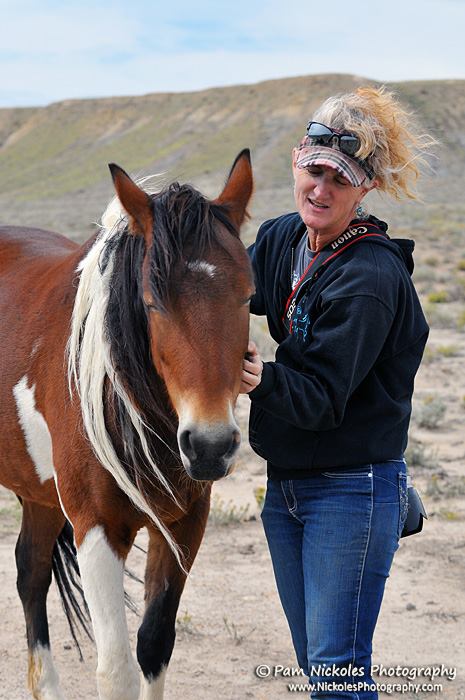
T.J. Holmes
TJ Holmes is president of the National Mustang Associations Colorado Chapter and a member of the Disappointment Wild Bunch Partners, a group dedicated to documenting the herd.
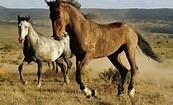
Spring Creek Basin wild horses credit Pam Nickoles/TJ Holmes
She is in the unique position of working both to preserve and protect these wild horses as well as with the BLM. It is an unusual partnership, states like Utah and Nevada do not frequently see a public-private partnership like the one between TJ and the BLM. To their credit, the BLM’s Colorado branch states the lands are public, strategizing end executing their management should be in partnership with the public. TJ is an invaluable source of data not only in monitoring the horses, but providing facts about the land. She is able to use her knowledge of the horses to help oversee the roundups facilitated by the BLM. Sadly, even with her there they don’t always go well. TJ has agreed to show us around today-which at times involves driving backwards in her pick-up truck down portions of the steep and narrow winding trails and ditches that -on drier days- pass for roads. I was expecting to come West and reacquaint myself with how barns worked and maybe saddle up a horse and ride. I was looking to research mustangs in particular
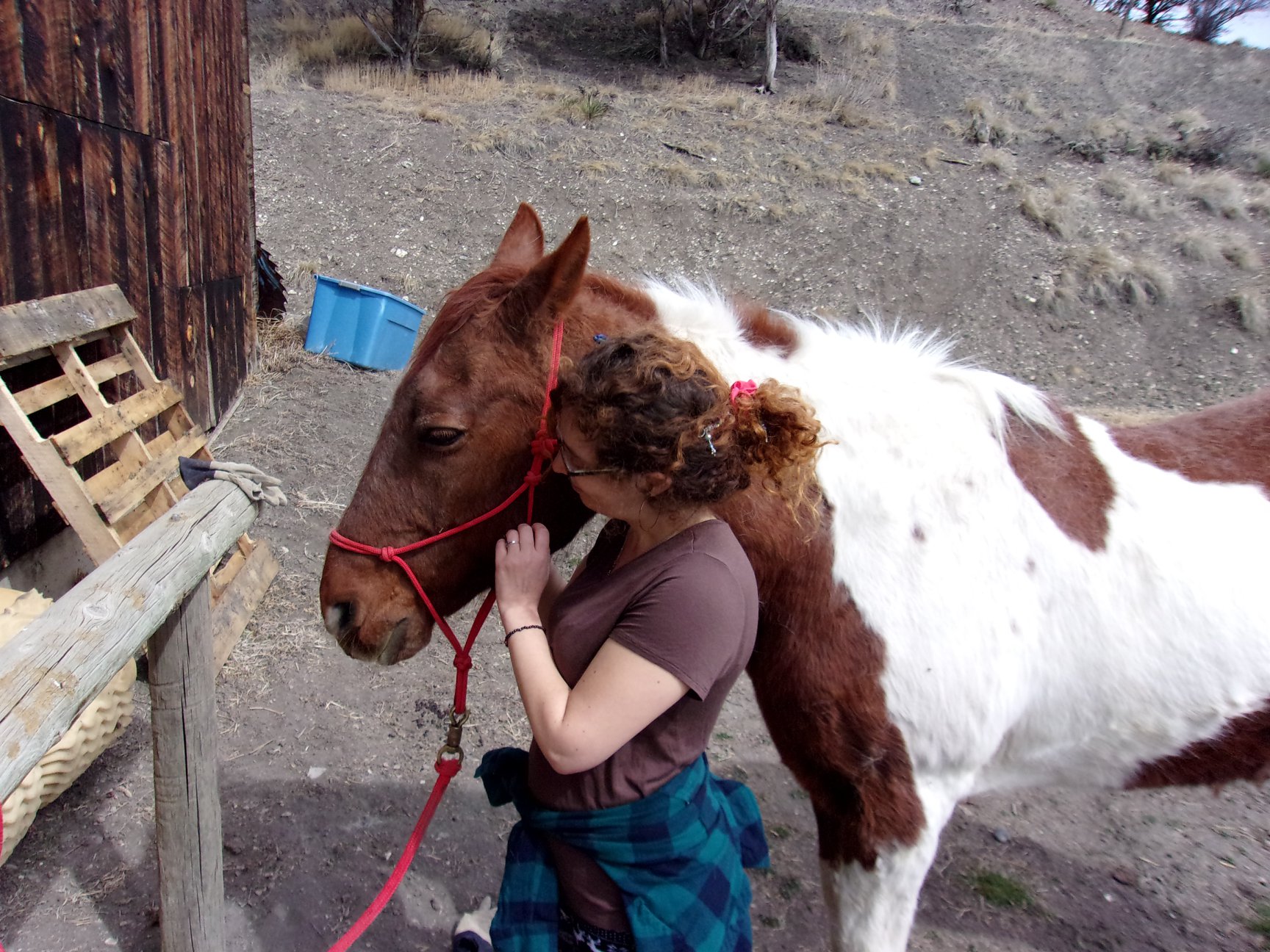
Me and Scout at Alice’s Ranch
because my play The Wildest Ones examines the parallel between America’s wild horses and troubled teens. Instead I am standing in an even larger story, smack in the middle of a fight for public land, for what in its essence belongs to the people and what is private. At stake is the very survival of the horses themselves, and more broadly, what it means to be “America”. Music and land have much in common, both seem to be crucial to our identity; this is where we are from, this is who we are. When a Grammy is awarded, a benefit is handed to an artist. That artist is the beneficiary of more than accolades- a Grammy is currency in the music world. The Grammy isn’t the issue itself; it is emblematic of the pinnacle of accomplishment in an industry notorious for its mistreatment of artists; much like the issue of the public lands, who owns the land (or artists’ songs) who gets to benefit from it, and who gets to decide this, is a backroom story that often fails to reach the public and the artists themselves. Like the horses, artists are often caught in the shifting of tectonic forces beneath them, without means to defend themselves. Often neither benefit nor survive. Ford’s best selling coupe, which is also the best selling coupe in the world, is the Mustang- so named because of its distinctly American DNA, its muscular stance, it raw, wild beauty. We value the mustang’s beauty when it is packaged in a Mustang, much as we value music, but not necessarily musicians or the right of the horses to live on the public lands.
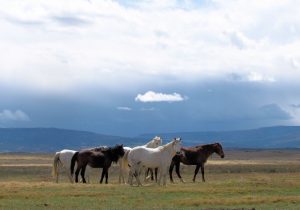
credit RunningHorses.org
The wild horses (commonly termed Mustangs) arrived to America the same way most of the rest of us did -from somewhere else. Their origin point was hundreds of years ago from Spain. A century ago 2 million mustangs roamed the wild; now there are less than 25,000. These animals graze over huge swaths of land, covering distances twice the length of Manhattan in a single day on their daily quest for food and water, and the existence of wild land is necessary for their own existence. The question is, is either the wild land or the horses -or music- necessary for ours? Who deserves to use the public lands? Is it the public and the horses? Or the ranchers who reapply annually for grazing rights? Cattle raising is an expensive -and profitable- business, and not having access to public lands would put some of these ranchers under. Every year, the existence of the Mustangs on the national park lands threatens the ranchers survival. And every year, the population of the Mustangs decreases, rounded up in larger and larger numbers by the Bureau of Land Management. This is a story that winds all the way back to Washington, D.C., where lobbyists for ranchers fraternize with politicians who control the land laws. The laws that decide who gets to benefit, and who will not, are written among this small group of mostly unknowns.
The horses are beautiful; fierce and wild. We see three separate herds, containing around 8-12 horses that I can see. In one case, we see a herd of just 3 horses. I watch them for hours as TJ explains to me the psychology of herd behavior and the genealogy spanning decades for each horse. She points to another, Hook, a tall chestnut who has recently come into his own as a herd leader. He comes from a family of horse-herd leader royalty and is in the prime of his horse life. She explains which horse belongs to which herd ,(or has recently left) who is mating with whom (or was); it is like a soap opera for horses. Finally, Alice and I go; it is time to meet John Billings, Grammy man. And as we say goodbye, TJ asks me this: “How often does the public use the public lands? What -and who- are they here for?”
It seems clear TJ has made up her mind, committing her life to guarding them and the wild horses on it. The National Parks and the wild horses are such a symbol of American identity, yet what do we do with them? A day ago, I didn’t even know a fight for their survival was at stake. Now I think about this all the way back down the Million Dollar Highway, passed the now-tiny depressed and shuttered towns of Naturita and Dove Creek where (if you are over 18) cashiers hand out dry ice along with groceries because the nearest store is often miles away.
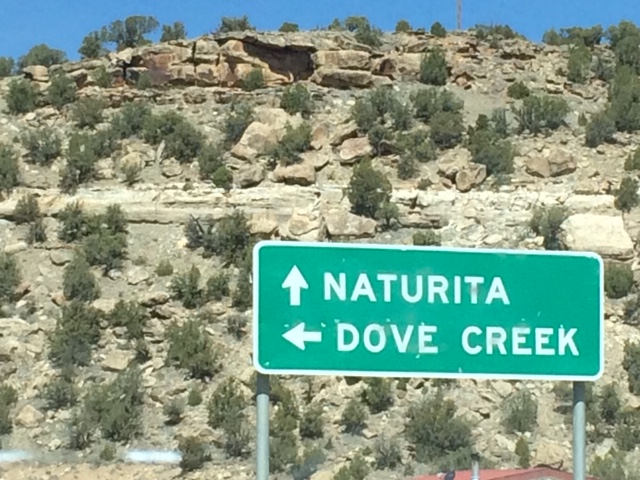
Depressed towns by Spring Basin Creek

Driving through Dove to Spring Creek Basin
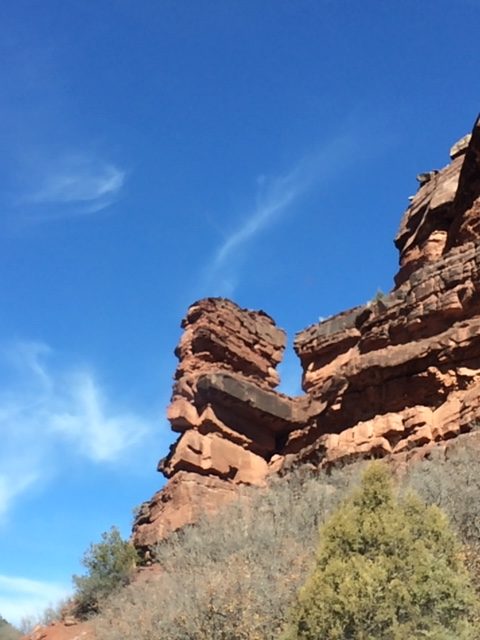
Dangerous Red Mountain Pass with iron oxide laden rocks
…”i used to ride my horse to town”
The Million Dollar Highway was built along what for hundreds of years was a watering route for animals; dinosaur footprints quite literally are on either side of the road. We head through Red Mountain Pass – one of the most treacherous passes in the world, Alice informs me gleefully as we drive through it. She squints to see better through the crack in her windshield that people here call a “Colorado Windshield.” Everyone here gets it, courtesy of the winter. As we near Ridgeway, Alice turns reminiscent. She points down the road.“I used to ride my horse to town.”
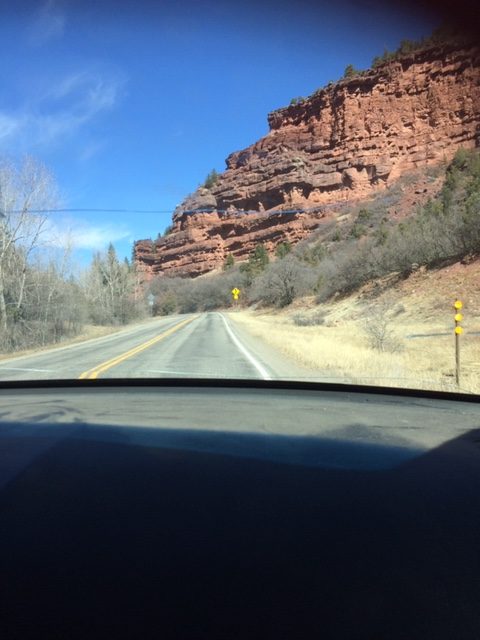
Colorado Windshield
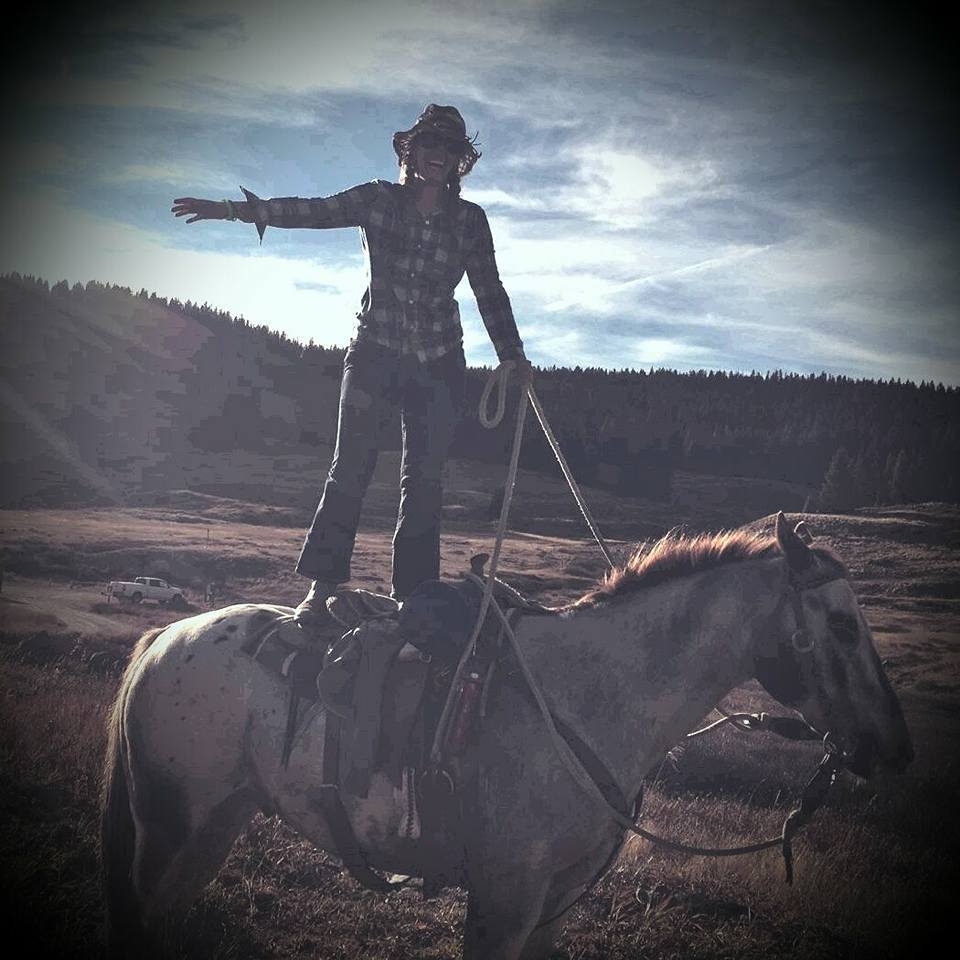
Alice Billings on Gus
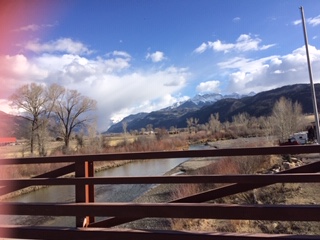
Across the new highway from John’s Billings Artworks
The small shop where the Grammys are made (Billings Artworks) is located around the corner from the Lucky Finds Consignment store, and across the street from the Sherbino Theater, built circa 1930. Development has come to Ridgeway and next to the Sherbino is a new organic, vegan, gluten-free eatery run by a former New Yorker (like everywhere else, there’s a lot of them here) who used to own a nightclub back in New York. A highway that -like the sidewalks- was a year old, separates the theater and store from the Grammy shop. Likewise, streetlights and benches had just been installed. Ridgeway, home of the Grammy-maker (there used to be a sign that said as much) is 985 people large, and another former mining town.
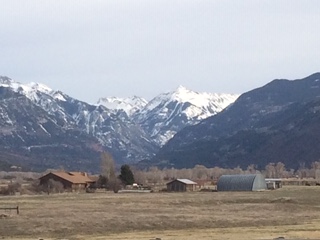
Ridegway, Colorado
It still retains its old west feel, and the restaurant True Grit on the corner marks the place where the original True Grit was filmed; pictures of John Wayne grace the wall inside. In the 1940s, the government decided to use the town for military purposes, and no one was allowed to sell their houses, or do any construction, effectively freezing the town in time. Decades later, having done nothing, they finally released their hold on Ridgeway, setting it up for a boom. Thirty feet away from True Grit is a completely renovated three acres of land converted into a western frontier block built by one woman for her own private use; I could only imagine what she did there. Ralph Lauren’s ranch, where Alice was once hired to give square dancing lessons for a party, is only slightly further away, at the nexus of Ridgeway’s new highway and the Million Dollar Route, which climbs 1100 feet through the mountains to Telluride traversing the aforementioned Red Mountain Pass, so named for the abundance of Iron in the rock which lends the red hue to the Earth.
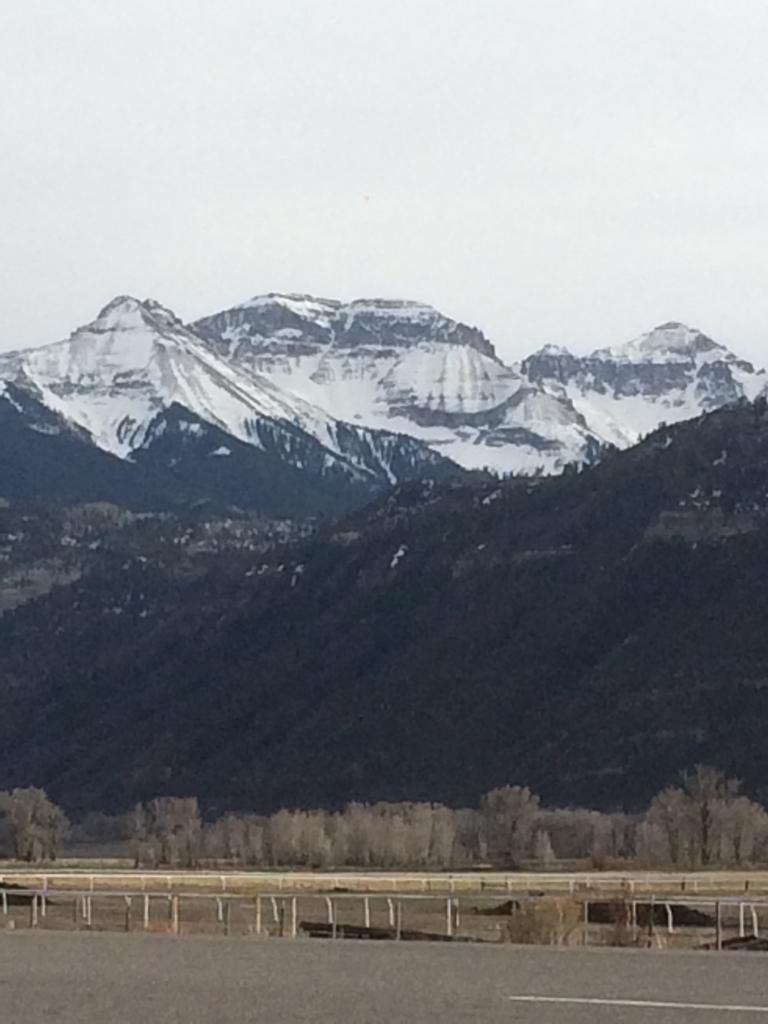
Across the street from Ralph Lauren’s ranch
Development, like the wild horses and the Music Industry, is complicated. Who gets to claim a piece, and why, seems to come down, as per usual, to money and power. It is not clear who in Ridgewood is seeing the benefits, the businesses that used to be along Main Street, before it moved two blocks away, have mostly closed. The nearby town of Grand Junction, with all its bucolic splendor, is reeling from 7 teen suicides in the last year when I arrive, and there were two suicides here in Ridgeway last year as well. A memorial service for them is held the day after I arrive. The shaken region is belatedly adopting suicide prevention practices. Housing prices are booming, but the people who could afford the prices are not from here, nor are they buying to stay; these homes will be used for the occasional vacation or rented out on AirBnB. Notwithstanding, home buyers were purchasing large amounts of water rights along with houses, leaving cattle raisers, horse owners, and farmers undersupplied which in turn pushed up the price of hay- a “staple” for all the ranchers in the area that has put still more pressure on their profits. The Colorado River has become over allocated, with its natural flow completely controlled and altered; this is exacerbated by the current drought. Unemployment here is very low, but somehow so are wages, and Keith, Alice’s 40 year old hired hand, slept in a tent on a hill above her barn when he was not freelancing wrangling the occasional bear who came to town seeking food to prevent them from startling tourists. Yet the town itself is beautiful, and the people enjoy the type of outdoor lifestyle sold in LL Bean advertisements. The film festival in Telluride brings the wealthiest of the wealthy to play and ski on the bountiful slopes here every year. The glossy veneer is irresistible, but just beneath the surface a very different narrative is playing out. This, is the birthplace and inheritance of the Grammy.
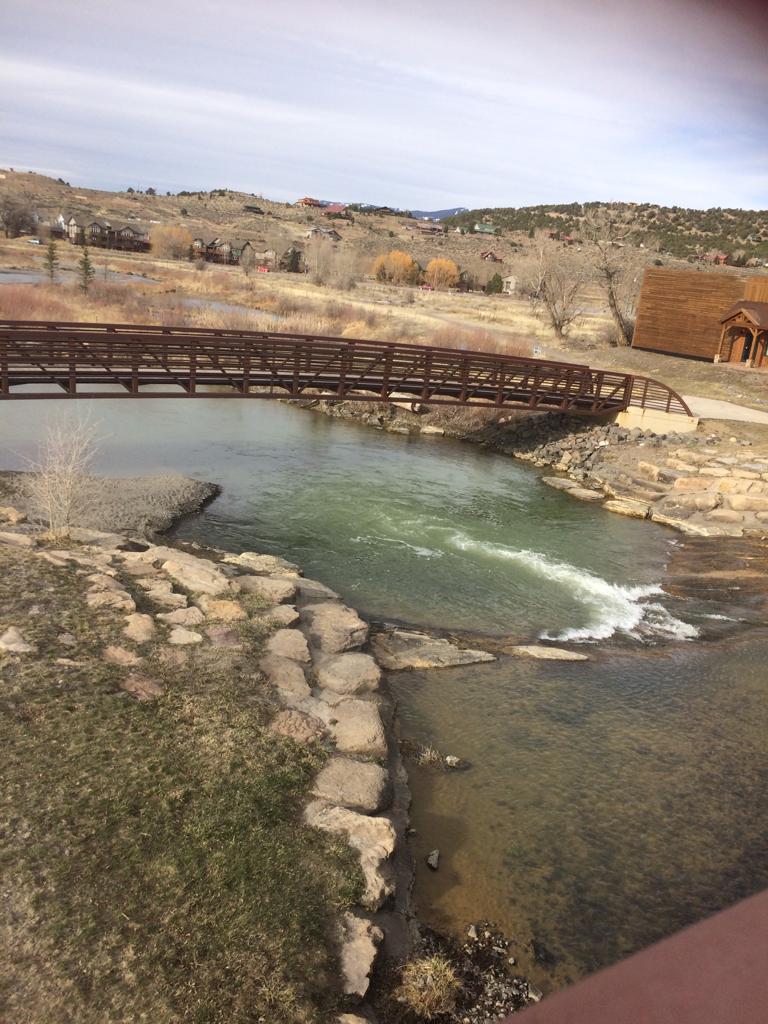
Down the road from John’s workshop
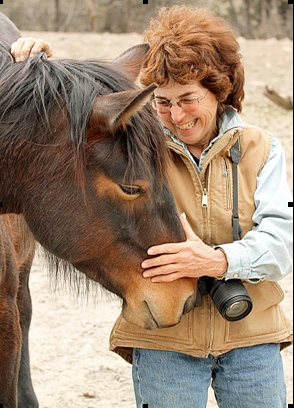
Alice with Libby, her mustang. Credit Alice Billings
John the Grammy Man and his former wife, “horse-lady” Alice Billings, came from California to Ridgeway in the 1990s. She was the personal assistant to the late Dennis Weaver; actor and environmentalist. The Weaver family had hired John to build light fixtures for the Weaver’s new environmentally friendly home the “Earthship.” Alice and John took one look at the valley of Ridgeway, nestled in between the mountains, and fell in love. Back then, there wasn’t much there but horses, country, and more horse country. Alice wasn’t the only one who rode her horse to town. Back then they were soaked in whiskey and floating on the buoyant promise of untamed country which was flat enough -despite the mountains- for the horses to run wild. Now, the town has become a popular springtime destination for tourists seeking its eco-friendly farmers markets, music, art, and the wonderful outdoor opportunities along the river, all surrounded by the soaring, permanently snow-capped San Juan and Cimarron mountain range.
And although I’m just here to work on my play, I can’t resist the crossover between the Grammys and the music world of The Arc, itself nestled between auto shops and Northern Boulevard in Queens.
A white El Camino lettered with “Billings Artworks” is parked outside a small shop. Two signs are casually taped on a low door; one reads “UPS YES”, and the other, firmly underlined: “No Tours Today”.
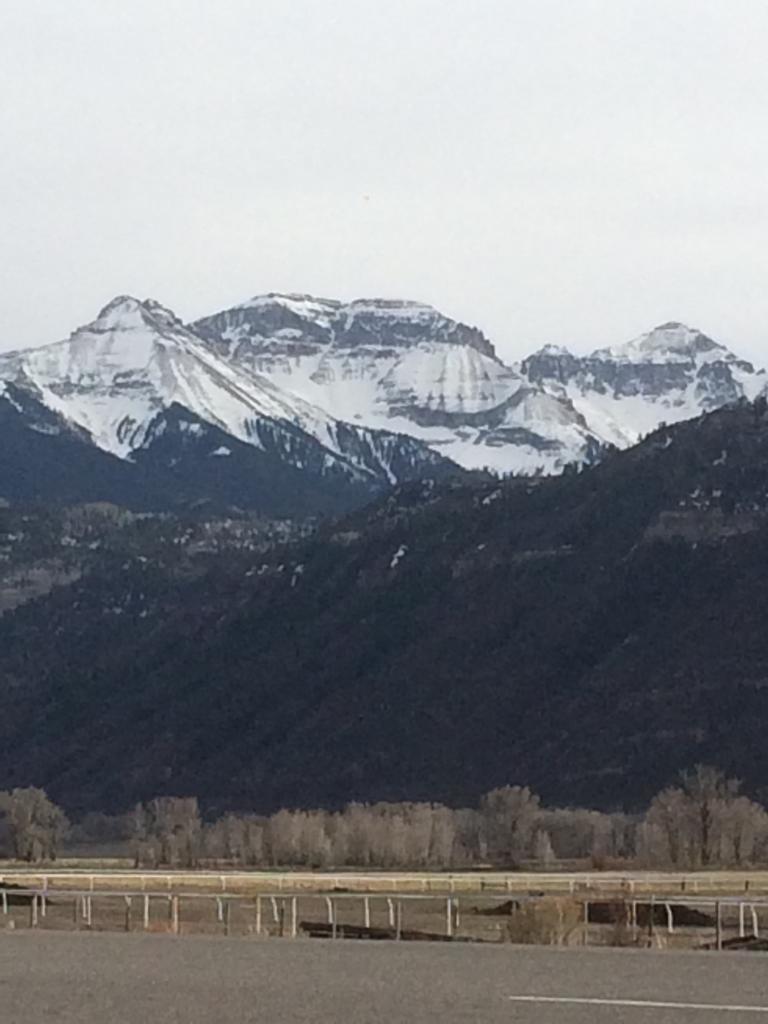
Snow Covered San Juan and Cimarron Mountain Range
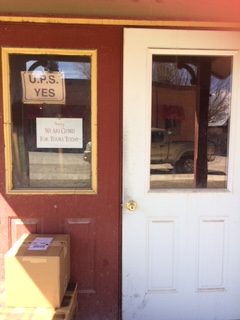
The outside of Billings Artworks, where the Grammys are made
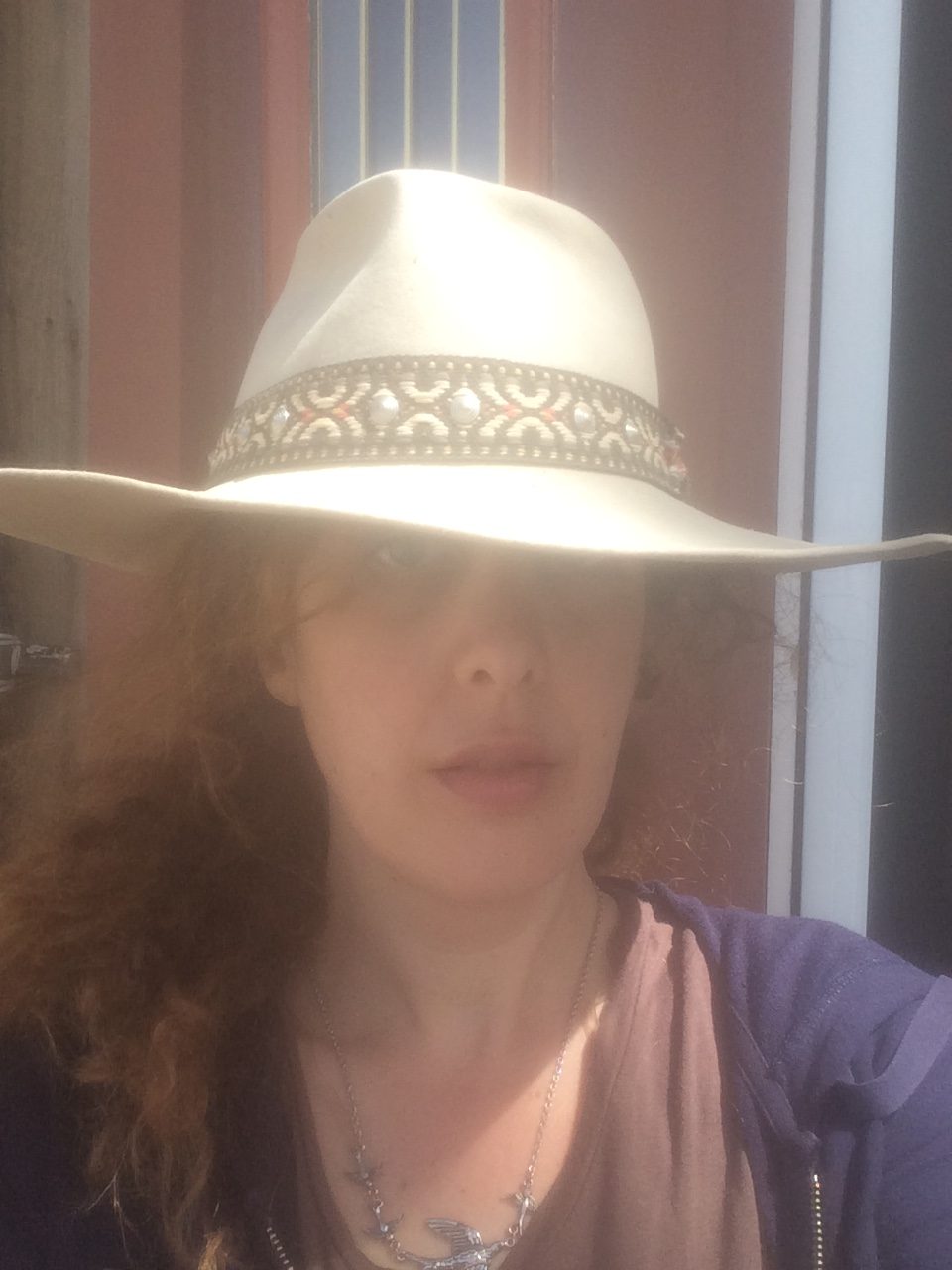
Me in my gifted hat -thank you, Alice!
Alice has put on her best cowboy hat for the occasion, and I am wearing the one she gifted me. The inside of her truck is covered with horsehair, mud, and straw, and it gets on our already muddied clothes. When we get out of the truck and enter the shop, we leave a trail of straw and mud-covered footprints behind us and her dog bounds behind us barking excitedly, but the men who work at the shop greet Alice and me with friendly grins and firm handshakes. A trail of mud and straw is common for Alice, and people everywhere in Ridgeway greets her this way. John, a quiet man with a white moustache and matching goatee, wearing a dark shirt that reads “Ridgeway, home of the Grammys,” stands up from his crossword puzzle. He ducks suddenly as people approach and motions us quickly over to a darkened corner of the room to hide with him, so that the people outside won’t -despite the “No Tours Today” sign- see us and come in. The puzzled grammy-maker seekers try the door anyway, but after a moment they go away, and we step out from hiding. The sign does in fact fail to deter a determined group of tourists who come by later while John is showing me around after Alice leaves.
John and Alice chat for a minute about the ranch (he used to live there) and his shop, the old days when they used to go out dancing – this was the ex-husband who bought Thunder for her from that Mexican cowboy years ago, but after a fall from a horse, he stopped riding – at last, they appear to run out of things to say. She kisses him goodbye and whistles for the dog, who has been greeting John excitedly, then gets back into her pick-up truck. She still has to go to the feed store, and doesn’t like to leave Thunder alone for too long these days. John stands there a moment after Alice leaves looking at the floor, then clears his throat and says, “Well, would you like to take a look around?”
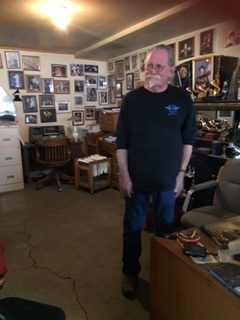
John inside his studio, Billings Artworks
The shop is covered wall-to-wall with memorabilia, there is barely room to walk through, and next to this room is another which used to be a recording and rehearsal studio for John’s band and other local musicians.
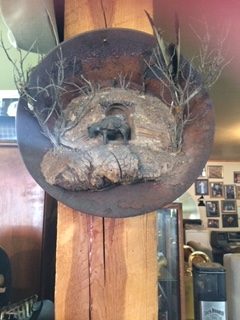
Inside Billings Artworks

Inside Billings Artworks
A large picture of a blue Gramophone catches my eye, I can not tell if it is a photograph or not. I am impressed by the array of artwork, and even more intrigued by this man who makes the Grammys, so far away from the world of the music industry. The wooden walls are filled with autographed pictures of musicians holding their awards, cast sculptures of horses, dogs, lamps -John also makes molds to cast bases of Tiffany Style and Art Deco lamps, he even made replicas of light fixtures used in the movie Titanic. Michael Jackson’s childhood Motown ID card is in a case with other precious memorabilia, Jack Daniels signature bottles, old Coca Cola bottles, and Grammy posters. I would love to pick up the wine bottles with autographed Rolling Stones labels but am worried I will drop it, and John points me towards the many Grammys, showing me a broken one autographed by Taylor Swift who apparently did drop hers and break it. They made her a new one; the original sits here, cracked like the Liberty Bell, but intact, sort of. John shows me the famed Convoy Duck: This nickel-plated Convoy duck smoking a cigar on the hood of a truck in the 1978 movie “Convoy” was re-used by Tarantino in his film “Death Proof,” and is well-loved by truckers.
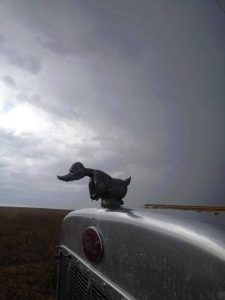
Death Proof Convoy Duck Hood Ornament
The Convoy Duck has provided John with some of his largest source of revenue over the years. The Grammys themselves actually aren’t that profitable a contract. The work is demanding and the hours are merciless, John’s scarred arms show the price of his devotion to hot-metal. The real pull for John (who had his original training in dentistry) lies in his love of the work involved. He finds immense fulfillment knowing that what he makes will change artists’ lives. In the back of this room is another, larger one. This is the workshop where the Grammys actually get made. It takes 15 careful hours of work to assemble each statue, piece by piece. And up to 700 awards must be made. Each trophy weighs roughly 5 pounds and is 8.5 inches tall, John has a staff of three to help him. The gramophones given out on the award show are actually recycled Grammys so if they are accidentally dropped in the excitement of the moment it won’t matter. Winners usually receive their customized award within 60 days. In the past 35 years, John has made over 8000 grammys; he thinks of all of them as his children. One of his favorite moments was when Bob Dylan won the lifetime achievement award, and he realized he had inadvertently made an award for his hero. It brought him to tears.
John and his staff work from 7am to midnight molding the awards here- but this isn’t where the story ends. Once the Grammys are made, John drives the awards across the country to California to make sure nothing happens to them on the way, then personally hand delivers them. With his white beard and slight paunch, I can’t shake the feeling John Billings is the Santa of the music world, his elves work in the casting room churning out presents, only instead of the reindeer drawn sled he has a Ford 350 and the presents are all newly built Grammys, made of his secret allium, “Grammium.”
I ask John if he has any memorable stories from driving the Grammys across the country, and he laughs and says he’ll tell me one. He grew up with a deaf brother, which made him appreciate the hearing he had, even though it was only in one ear (this did not stop him from becoming a musician). Over the years this has rarely given him trouble, but one time en-route his road-trip Grammy run, he was stopped as per usual upon entry to California by the Food and Agricultural inspections man, who asked him “Do you have any future plans to declare?” So John said, “Yes, I do.” And the guy said, “Well you’d better pull over.”
Now of course the man had asked if he had any fruits or agriculture to declare, but John’s mind, I imagine, was on the next Grammy run, the next build, and when the truck was inspected, instead of fruits or agriculture, the officer found hundreds of gleaming Grammys. John walks me through the paintings on one wall, telling me which artist made each Grammy poster.
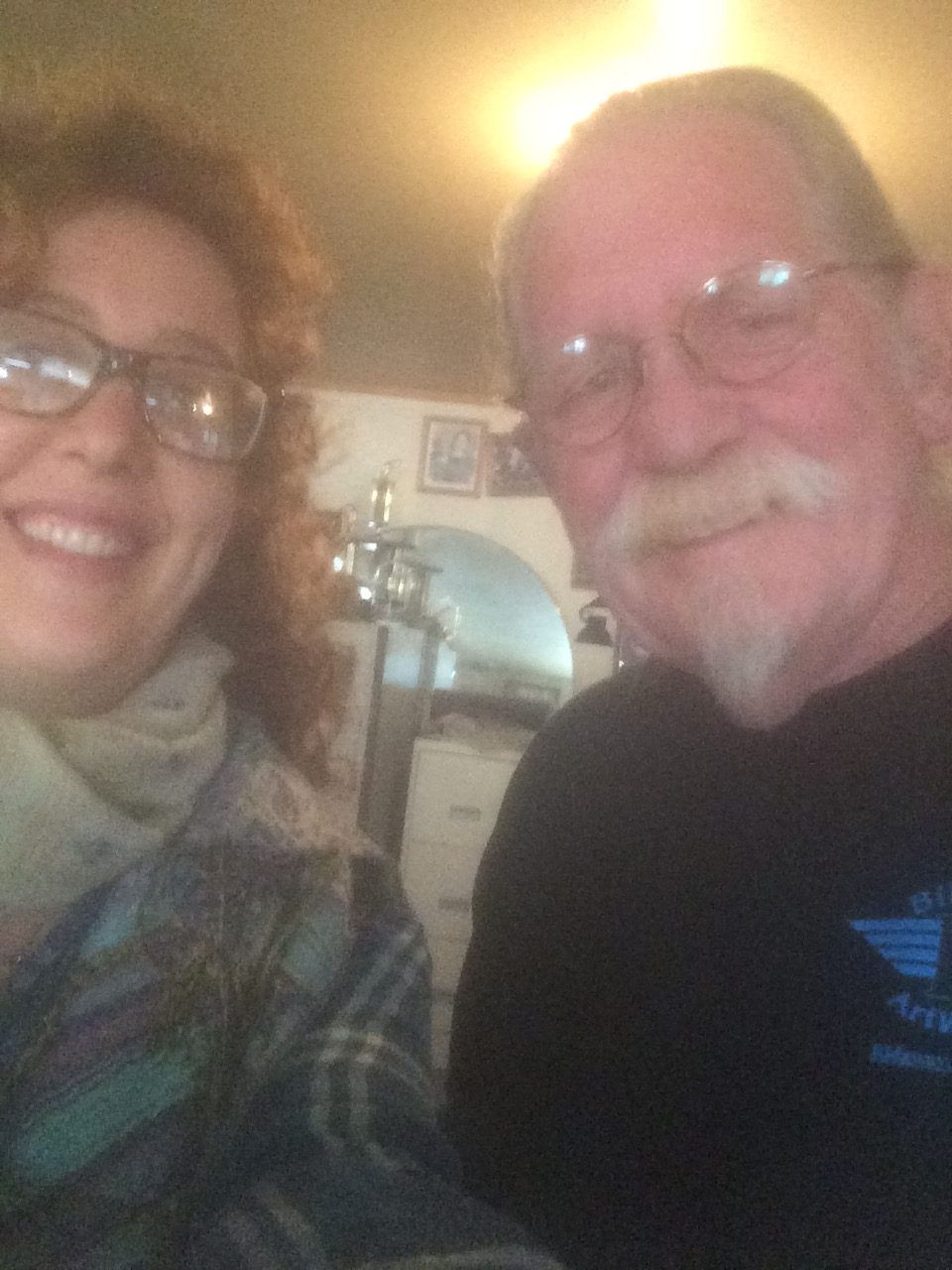
John and I inside Billings Artworks
We stop in front of an impressive Picasso-looking design, and he tells me it was made by a ten year old girl, then points to another, dreamier image, made by a homeless man discovered -for this moment, anyway- on the streets of L.A.
One of the first stories John tells me when I come in is about a woman named Trina Shoemaker, a sound engineer.

Trina Shoemaker accepting her grammy. Credit Marsha Vdovin, Universal Audio WebZine
“Now over there,” he points to yet another shelf loaded with Grammys, “is a Grammy belonging to John Legend, and if you look next to it, there’s a Grammy for Trina. She’s a sound engineer, we make all kinds of Grammys, people don’t realize it’s not just for the artists, it’s for the writers, the engineers, producers, mixers, re-mixers, mastering engineers, it’s a long list.”
I throw in that as a writer myself I greatly appreciate that.
“So this here Grammy went through Hurricane Katrina,” he says, “Trina’s a single mother, and she had a baby in one arm, and had to figure out what to grab with the other. She had other priorities at the time. So she left the Grammy, and when she came back it was all covered in mold.”
He sits back down, looks at some papers on his desk reflexively. “Now John Legend has some nephews, and they were playing with his Grammy. Well, they dropped it, and it broke. So he called up the Grammy people, and asked could he get another one, and they said, yes, right away. Now Trina calls up, and she says, my Grammy went through Hurricane Katrina, and it’s all covered in mold, can I get another one please? and they say No.” He pauses, “So there’s a different level of appreciation for all the different artists going on there.”

LOS ANGELES, CA – FEBRUARY 13: Musician John Legend, winner of the Best R&B Album award for “Wake Up!” and Best R&B Song award for “Shine” and the Best Traditional R&B Vocal Performance award for “”Hang on in There”” poses in the press room at The 53rd Annual GRAMMY Awards held at Staples Center on February 13, 2011 in Los Angeles, California. (Photo by Kevork Djansezian/Getty Images)
The conversation moves into talk of his long work with the Grammys. He initially became involved with the Grammys when, growing up, the father of his best friend next door was the original Grammy maker, Bob Graves, who made the first-ever Grammy in his garage. He took over the business on Bob Graves’ deathbed, promising to never let it “leave the family,” and has been making them ever since they were a small, little-known award ceremony. Despite that, he still has to wait each year to see if he will be given a new contract for this year’s Grammy again. For their part, the Grammys people are quick to mention their deep appreciation for John’s work, and to their credit have renewed his contract each year. When we meet, he is in the middle of bidding on the next round of contracts. The Grammys is the last large award that is still made personally, by hand. The Golden Globe, The Emmys, The Academy of Country Music, and the NAACP awards are all factory made, perhaps overseas, and then shipped back to a warehouse in Nebraska. No one is hand-making them, let alone personally driving them acr oss the country to hand deliver them besides John anymore. Despite this, John is left wondering every year if his Grammy contract will be renewed again, or if next year’s Grammys will be made in a giant factory overseas somewhere where it is perhaps cheaper to produce them and pay for labor. I ask John if I can hold John Legend’s broken Grammy, and he says yes. The lines of the design are perfect, the thrill of it undeniable in my hand; this small award, not even nine inches, has the power to change people’s lives.

The Grammy.
… “i haven’t had to work in 40 years”
I am amazed when John insists he isn’t an artist, and instead humbly fashions himself a tinkerer. His paintings hang on the walls, next to meticulously crafted awards. When he and Alice were worked out of the shop together years ago, they had an art studio above the store and held classes. They like to tell how they both shared the same pallet, but John’s work was meticulous, specific, and realistic, while Alice’s was free-range, quick, and abstract.
“Now this here,” he points to an older looking Grammy with a small filigree that looks like a handle connecting the main body to the top of the award, “this was always a problem piece, it was always breaking off. So one day the Grammys people said to me, John, can you design me a Grammy that is three times as large so it can really be seen on TV?”
John pauses, his hand brushing the smaller Grammy. His eyes dart to the door, but this time the “no Tours today” sign has worked its magic, and the group of passerby’s moves on.
“So I thought about it for a couple years,” John says, and I note the time on the recorder, assuming I have misheard or misunderstood him, but when I check later, “a couple years” was indeed the amount of time he thought about this for.
“And then one day,” John goes on, “I sat down and drew it. See I was thinking about New York. I was always scared to go, I thought “New York!” that’s the Sharks and Jets, and then I went, and my mind was just blown, it was so Art Deco. And then:”
He holds up the currently-distributed Grammy, it is clearly Art Deco, the lines are smooth, almost exaggerated, it is a fuller, bolder design. New York in 8 inches. He points to the connecting arm that previously had given him so much trouble: Now it is thick, veined with lines, clearly durable. It reminds me of the picture he has in the other room that used to be the recording studio for his band and friends, a deep blue, swirling Gramophone with surprisingly sharp details; John tells me it is blended art: A polaroid the artist had drawn over.
“I finished it up and brought it into the office,” John says, “And the Grammy people who wanted that bigger design jumped up out of their desk and shouted: That’s it! That’s what we’ve been looking for! And then I found out they’d already put the design bid out to other people besides me, they showed me all different other prototypes. But this one was it.”
He shrugs.
“I don’t have a job.” His face creases into a smile, “I’m always amazed when I think about it,” his hand gestures around the shop, at all the different models, awards, signed paintings and Grammys, “I haven’t had to work in forty years.”
John got his contract renewed for the 2019 Grammys; Hook was killed in a round up a short time later, after he ran into a wall panel and broke his neck; I return to my horses at The Arc. Thunder passed away the day after I get back.

Hook, by Alice Billings
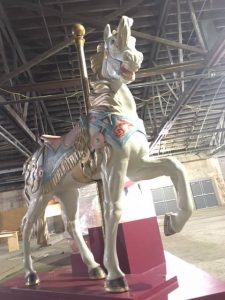
Horse at The Arc
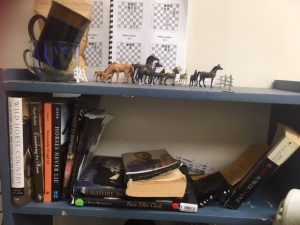
My horse herd at The Arc; partial horse book library
